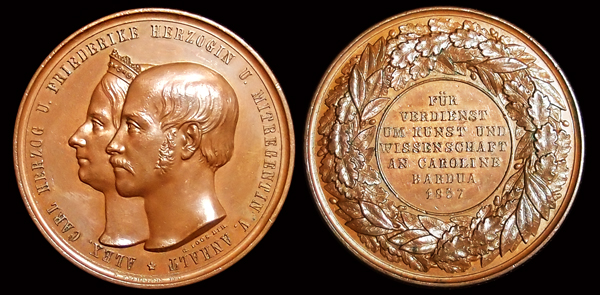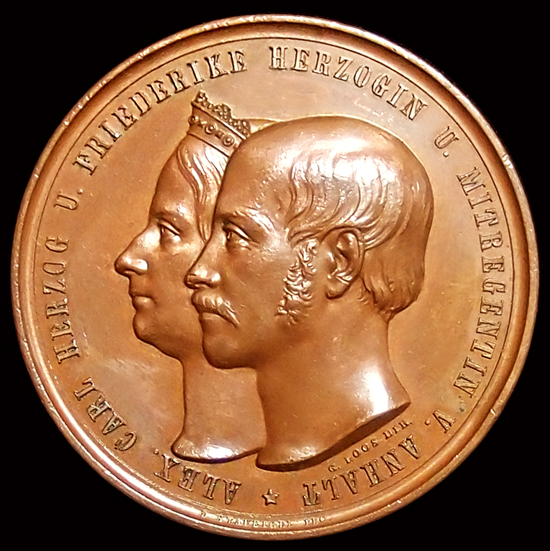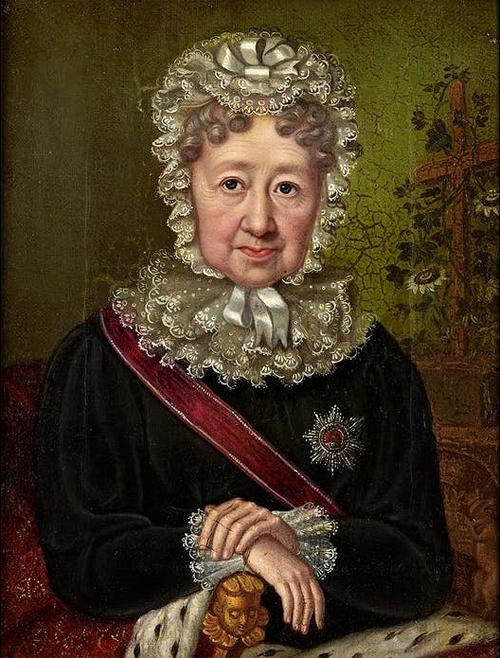
BRONZE MEDAL - ANHALT AWARD FOR ARTIST CAROLINE BARDUA
Anhalt
Medal Depicting the Duke and Duchess of Anhalt-Bernburg, Oak Wreath, and Inscription Recognizing Artist Caroline Bardua for Achievements in the Arts and Sciences. The medal was created by the Loos Medallic Establishment, founded by Gottfried Bernhard Loos, and engraved by F. Staudigel.
Depicted on the obverse of this medal is Alexander Karl, Herzog von Anhalt-Bernburg of The House of Ascania, and his wife Friederike Herzogin von Anhalt-Bernburg. The reverse of the medal shows a wonderfully detailed wreath of oak leaves. The inscription attributes the medal as an award given to the painter Caroline Bardua for her achievements in the arts and sciences.
Under his rule the duchy would expand as it incorporated the lands of Anhalt-Kothen upon the death of the last of that family's line, Duke Heinrich, in 1847. With land disputes resolved it would be under Alexander Karl's tenure that the railway would come to Anhalt and several schools for the underprivileged of the small duchy opened. It was said that the young Duke Alexander Karl's health was of a 'weak nature' for most, if not all, of his life. As a juvenile it is reported that he was already showing a 'weakness of spirit.' By 1855 the Duke was suffering from what had become a debilitating mental illness and his wife Friederike was appointed as Mitregentin (co-regent), of the Duchy to be aided by Duke Leopold of Anhalt-Dessau. Alexander Karl and Friederike were avid patrons of the arts and had many artists as friends and in their employ. One such artist was the Russian born painter and writer Wilhelm von Kügelgen who was hired as a court painter. He was later appointed as chamberlain to the Duke serving from 1853 as his aid and companion during his years of decline. An accomplished artist and writer he gained further notoriety after his posthumously published book, Jugenderinneru-ngen eines alten Mannes (Youthful Memories of an Old Man), became a favorite among the upper classes. Wilhelm von Kügelgen was the son and student of the great portrait and landscape artist Gerhard von Kügelgen. One of the more prolific and sought after portrait painters of his time. He painted many of the artists, writers, scientists, and leaders of the era including portraits of the Russian Tsar and his family.
Caroline and her sister, the singer Wilhelmine Bardua, traveled extensively making stops in Paris and Frankfurt until settling in Berlin where they found a measure of success founding Salon for German artists, writers and musicians. Here she and her sister would become well respected artists moving easily within the German artistic community. Unfortunately her career took a turn for the worse when she was exhibited her work along side the academically trained Friedrich Wilhelm von Schadow where her paintings received negative reviews and were unfavorably compared to his causing her to lose much of her business and with financial difficulties. Unable to support themselves in Berlin, she and her sister left the city in 1827 moving from town to town for the rest of their lives. The two never married and lived together where ever they found themselves until Coraline's death in 1864. After her death, Wilhelmine wrote a biography of Caroline called 'Das Jugendleben der Malerin Caroline Bardua' or 'The Youthful Life of the Painter Caroline Bardua' which was published in 1874, after her own death. Even though she had suffered a set back in Berlin, Caroline was a talented, well respected and sought after portrait artist. She is one of the few female artists of her time who hailed from the middle class to establish a Salon or to work and support herself as a successful and respected working master portrait painter. Among her body of work are outstanding portraits of important people of her time like Caspar David Friedrich, Johann Wolfgang von Goethe's wife Christiane, Johanna and Adele Schopenhauer, and a stunning portrait of Dorothee van Herzeele (pictured Below).
This Medal was awarded to Caroline Bardua for her contributions to the arts in 1857 when the artist was 76 years old, seven years before her death in 1864 at the age of 83. Wilhelm von Kügelgen would have been 55 in this year, he died ten years later in 1867 at the age of 65. As for Duke Alexander Karl, his feeble rule and the disturbed stale of Europe led to considerable unrest with the people who looked for social change. A number of abortive attempts were made to change the government and for a time the principality was occupied by Prussian troops. Leopold of Anhalt-Dessau appears to have taken some part in the affairs of the ailing Dukedom of Bernburg. In 1859 a new constitution was established for Bernburg and Dessau jointly. Alexander Karl was eventually committed and did not leave any children upon his death in 1863, at the age of 58. The line of Anhalt-Bernburg ended without an heir. The Duchy of Anhalt-Bernburg ceased to exist as it was annexed by Leopold of Anhalt-Dessau. Duchess Friederike died in 1902 at the age of 90. She died at Alexisbad, a small spa town founded by Alexander Karl's father, Duke Alexius. The town was popular with the German upper class in the late 19th century for its iron rich waters said to have medicinal properties.
|











